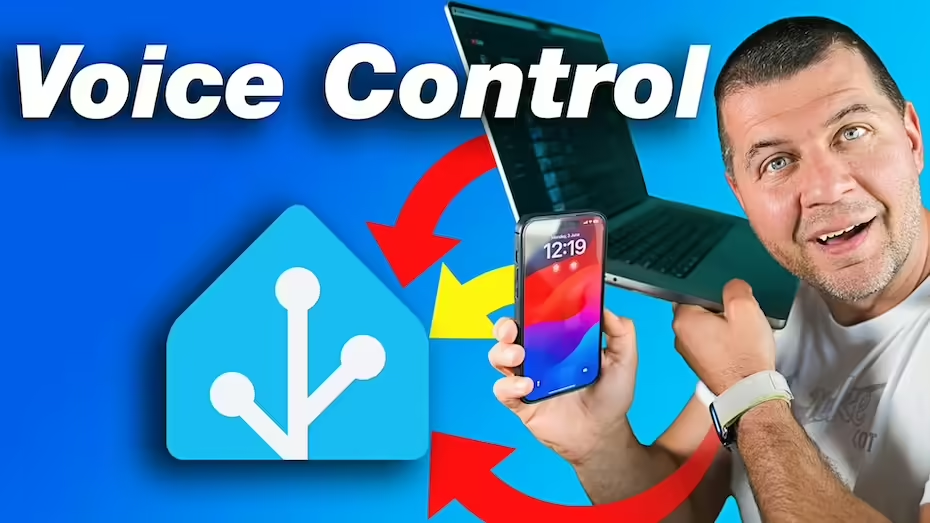I’m excited to test the voice control Home Assistant’s capabilities on various Apple devices. If you’re an Android user, please comment below and let me know if you’d like a similar tutorial for Android. If there’s enough interest, I’ll create a video for Android users too.
Let’s dive into testing Home Assistant on an iPhone, MacBook, and Apple Watch!
Table of Contents
Home Assistant companion app, Siri Shortcuts and a Pipeline
To voice control your Home Assistant from iOS, WatchOS or MacOS device you need to either manually create 2 Siri Shortcuts or you can just import them by clicking on the links below. These shortcuts are created form the official Home Assistant team and you can find the full article here.
It is also a good Idea to install and configure Home Assistant Companion App from the Apple AppStore.
And finally an Assist pipeline is needed where more info can be found in my previous Article/Video – Switching from Alexa to the ESP32-S3-Box-3: My Experience
Prefer Watching Over Reading – voice control home assistant?
If you’re tired of reading and prefer watching a tutorial, check out my video on this topic! It walks you through the setup process step-by-step.
Testing Voice Commands towards Home Assistant on iPhone
I’ll start with the iPhone 15, which features an action button (great “innovation” I know) . This button can be reprogrammed to do something more useful than just muting the phone. In contrast, older iPhones, like the iPhone 7, have a mute switch that you can toggle on and off.
I’ll demonstrate various methods to voice control Home Assistant using the Assist feature from an iPhone. Here’s how you can do it:
Method 1: Shortcut on the Lock Screen
- Create a Shortcut: Lock your device, double tap and hold on your lock screen, tap on customize, Add a shortcut with Assist Button to the lock screen.
- Activate the Shortcut: Press the shortcut widget and say a voice command for example: “Turn on smart light,” and the light will turn on.

Method 2: Action Button (iPhone 15)
- Go To iPhone Settings: Program the Action Button to invoke Assist Button Siri Shortcut
- Press and Hold: Press and hold the action button to activate a shortcut.
- Say a command: As example “Turn off smart light.”

Method 3: Home Screen Widget
- Add a Widget: Add the Assist widget to your home screen.
- Tap the Widget: Tap the widget and say a voice command

Method 4: Back Tap (iPhone 8 or Newer)
- Enable Back Tap: Go to Settings > Accessibility > Touch, and enable Back Tap.
- Configure Shortcut: Set the double or triple tap to activate the Assist Button shortcut.
- Use Back Tap: Double/Triple tap on the back of your iPhone and issue a voice command.
Method 5: Voice Control
- Enable Voice Control: Go to Settings > Accessibility > Voice Control and enable it.
- Create Custom Commands: Create a waking word of your choice.
- Activate by Voice: Use the waking word and then the voice commands to control your Home Assistant & smart home.

Download Your Free Smart Home Glossary
I’m excited to offer a free Smart Home Glossary! This PDF file is packed with common smart home words and acronyms, with simple and useful explanations. Perfect for beginners and enthusiasts alike.
Download your free Smart Home Glossary now!
Testing on MacBook
The Home Assistant companion app can also be used on a MacBook. Here’s how:
- Install the App from the App Store: Download and configure the Home Assistant companion app.
- Import Shortcuts: Use the same shortcuts as on your iPhone.
- Add to Dock: Right-click the shortcut and add it to your dock for easy access.
- Menu Bar Access: Add the shortcut to your menu bar for quick activation as shown in the screen below:

Testing on Apple Watch
Using Assist Siri Shortcuts to voice control Home Assistant on your Apple Watch is kind of automatic if you already have it working on your iPhone :
Method 1: Complications
- Add a Complication: Tap and hold on your watch face, then edit and add the Assist complication.
- Activate: Tap the complication to run the Assist command.

Method 2: Siri
- Activate Siri: Hold the crown and say, “Assist, turn on smart light.”
- Hey Siri: Use “Hey Siri Assist” followed by your command, like “turn off smart light.”
Free Home Assistant Webinar
Join my free Home Assistant webinar! We’ll cover the four official ways to install Home Assistant, their pros and cons, and a simple way to get started on a PC in under 5 minutes.
Register now – This webinar is perfect for both beginners and those looking to optimize their setup.
Thank you for shortcutting with me! If you have any questions or want to see more content, leave a comment below. I’m Kiril, and I’ll see you in the next one!
